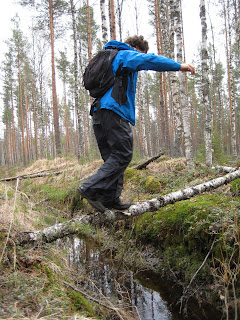Day 13
As always, well mostly always, I'll start with the news from T108 at KKN. Stratigraphy profiles were done of the north and east sides of the trench and then it was backfilled and covered up. That's all for KKN...exciting!
In trench T208 at the Thing it was realized that all the possible fire pits (including another one just discovered today!) go too deep to be completely excavated this year, so the trench will have to be filled and then re-excavated next year. The other news from the Thing is that about a third of the platform and surrounding area was mapped using the total station.
Another set of trowel tests was done at a possible site and stone structure that correspond to an elevation that roughly dates to the transition between the stone age and the bronze age. Three test pits were done in the possible stone structure and one test pit was done in a nearby dwelling depression. All pits were negative, meaning they didn't contain any finds.
As the excavation is drawing to a close more lab work is being done. Several people worked in the lab today and were cataloging finds, organizing finds, and cleaning charcoal.
It was also media day today. The local newspaper, radio, and television companies came out to interview Dr. Ezra Zubrow, Sam Vaneeckhout, Eva Hulse, and Jen Bracewell about the excavations this year.
Here are some pictures from Day 13.
 Stomping down the dirt while backfilling trench T108 at KKN.
Stomping down the dirt while backfilling trench T108 at KKN. Backfilled and turf replaced at T108, almost as if we were never even there...
Backfilled and turf replaced at T108, almost as if we were never even there...It's really the end now. Only a few people were sent to the field today, for the purposes of drawing stratigraphy profiles for trench T208 at the Thing, to back fill T208, as well as map the rest of the platform and surrounding area of the Thing with the Total station.
Besides that all that was done is lab work. People continued cataloging, organizing and all that fun stuff. Here are some pictures once again.
So that's all! My job is done. Well almost, let's run through some of the exciting things discovered in this year's excavations. A large new site was found by the survey team along the 55 meter coastline, dating roughly to 5000 years BP, which will hopefully be excavated in the near future. An amber bead was found on the south side of the Yli-Ii river at the KKN site for the first time ever, this was very cool. A large refitted quartz scraper was found in the test pits along the shore line from the KKN site, which matches the area's soil samples and supports the theory of the shore line being used as an activity site and possible midden in neolithic sites throughout the area.
The most important thing about this year's excavations is that they seem to support the proposed theory of social evolution throughout the Yli-Ii river area. The Pits site, which was theorized to be the result of early transient Hunter-Gatherer use, seem to be storage pits, while the dwelling depression at KKN contained no evidence of economic specialization. Both of these excavation results tentatively match the theory, as the Pits was located at the 63 meter coast line, while KKN is located at the 60 meter coast line. Remember that in this area higher elevation usually means older, thus the Pits is older than KKN, and this matches the social evolution hypothesis of increased sedentary life style and resource intensification over time (see the first posts for a refresher on this theory if you need it). Carbon dates and further analysis of the new pile of data collected this year will be needed to confirm or falsify these results, but so far, the theory stands. Unfortunately excavations at the Thing weren't completed this year, thus a full interpretation of the site will have to wait until excavations are completed next year.
There we go, synopsis of the Nocuso Archaeological Field School 2008 excavations complete and my job officially done. Hope you enjoyed the blog as much as I enjoyed writing it for you. Tune in next year I guess, hopefully the blog torch will be passed on to a 2009 member of the field school.
Cheers,
The Field School



















































